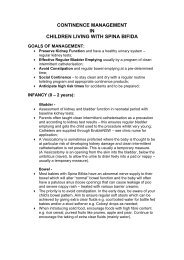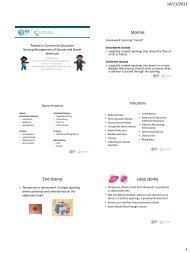PROLAPSE PROLAPS
PROLAPSE PROLAPS
PROLAPSE PROLAPS
Create successful ePaper yourself
Turn your PDF publications into a flip-book with our unique Google optimized e-Paper software.
16<br />
<strong><strong>PROLAPS</strong>E</strong><br />
<strong>PROLAPS</strong><br />
WHAT IS A VAGINAL (OR PELVIC ORGAN)<br />
<strong><strong>PROLAPS</strong>E</strong>?<br />
Your pelvic organs include your bladder, uterus<br />
(womb) and rectum (back passage). These organs<br />
are held in place by tissues called “fascia” and<br />
“ligaments”. These tissues help to join your pelvic<br />
organs to the bony side walls of the pelvis and hold<br />
them inside your pelvis. Your pelvic floor muscles<br />
also hold up your pelvic organs from below. If the<br />
fascia and ligaments are torn or stretched for any<br />
reason, and if your pelvic floor muscles are weak,<br />
then your pelvic organs (your bladder, uterus, or<br />
rectum) might not be held in their right place and<br />
they may bulge down into the vagina (birth canal).<br />
WHAT ARE THE SIGNS OF <strong><strong>PROLAPS</strong>E</strong>?<br />
There are a few signs that you may have a prolapse.<br />
These signs depend on the type of prolapse and<br />
how much pelvic organ support has been lost.<br />
Early on, you may not know you have a prolapse,<br />
but your doctor or nurse might be able to see your<br />
prolapse when you have your routine Pap test.<br />
When a prolapse is further down, you may notice<br />
things such as:<br />
a heavy feeling or dragging in the vagina;<br />
something ‘coming down’ or a lump in the<br />
vagina;<br />
a lump bulging out of your vagina, which you<br />
see or feel when you are in the shower or<br />
having a bath;<br />
sexual problems of pain or less feeling;<br />
your bladder might not empty as it should,<br />
or your urine stream might be weak;<br />
urinary tract infections might keep<br />
coming back; or<br />
it might be hard for you to empty your bowel.<br />
These signs can be worse at the end of the day<br />
and may feel better after lying down. If the prolapse<br />
bulges right outside your body, you may feel sore<br />
and bleed as the prolapse rubs on your underwear.<br />
ŠTO JE VAGINALNI <strong>PROLAPS</strong> (ILI <strong>PROLAPS</strong><br />
ZDJELIČNOG ORGANA)?<br />
Zdjelične organe čine: mokraćni mjehur, uterus<br />
(maternica) i rektum (čmar). Ove organe drže tkiva<br />
koja se zovu “fascia” i “ligamenti”. Ova tkiva vežu<br />
zdjelične organe uz koštane stijenke zdjelice i<br />
drže ih u zdjelici. Mišići dna zdjelice također drže<br />
zdjelične organe, s donje strane. Ukoliko se fascia<br />
i ligamenti iz bilo kojeg razloga poderu ili rastegnu,<br />
te ukoliko su vam mišići dna zdjelice oslabljeni,<br />
zdjelični organi (mjehur, uterus ili rektum) možda<br />
više nisu na svom mjestu i mogu se spustiti u<br />
vaginu (porođajni kanal).<br />
KOJI SU ZNAKOVI <strong>PROLAPS</strong>A?<br />
Nekoliko znakova može ukazivati da imate prolaps.<br />
Ovi znakovi ovise o tipu prolapsa i koliko je<br />
izgubljeno potpore zdjeličnih organa. Na samom<br />
početku možda nećete ni znati da imate prolaps,<br />
ali liječnik ili sestra može vidjeti prolaps prilikom<br />
redovitog Papa testa.<br />
Kada je prolaps dublji, možete primijetiti:<br />
osjećaj težine ili stezanje u vagini;<br />
kao da nešto ‘silazi’ ili zadebljanje u vagini;<br />
ispupčenje koje izlazi iz vagine, koje vidite ili<br />
osjećate kada ste pod tušem ili u kadi;<br />
seksualne probleme zbog boli ili smanjenog<br />
osjećaja;<br />
mjehur se možda ne prazni kao što bi trebao ili je<br />
mlaz mokraće preslab;<br />
infekcije urinarnog trakta mogu biti česte; ili<br />
možda vam je teško isprazniti crijeva.<br />
Ovi znakovi se mogu pogoršati pri kraju dana,<br />
a poboljšati kada legnete i odmorite se. Ako je<br />
prolaps izašao vani, možete imati bolove i krvarenje<br />
zbog trenja o donje rublje.<br />
NATIONAL CONTINENCE HELPLINE 1800 330 066 | www.bladderbowel.gov.au | April 2013 | CROATIAN Page 1
16<br />
<strong><strong>PROLAPS</strong>E</strong><br />
<strong>PROLAPS</strong><br />
WHAT CAUSES <strong><strong>PROLAPS</strong>E</strong>?<br />
The pelvic organs are held inside the pelvis by<br />
strong healthy fascia. They are held up from<br />
below by pelvic floor muscles that work like a firm<br />
muscle sling. If the support tissues (fascia and<br />
ligaments) that keep the bladder, uterus and bowel<br />
in place inside the pelvis are weak or damaged,<br />
or if the pelvic floor muscles are weak and saggy,<br />
then prolapse can happen.<br />
Childbirth is the main cause of prolapse. On the<br />
way down the vagina, the baby can stretch and<br />
tear the support tissues and the pelvic floor<br />
muscles. The more vaginal births you have,<br />
the more likely you are to have a prolapse.<br />
ŠTO UZROKUJE <strong>PROLAPS</strong>?<br />
Zdjelične organe u zdjelici drži jaka zdrava fascia.<br />
Odozdo ih drže mišići dna zdjelice koji se ponašaju<br />
kao čvrsta mišićna ljuljačka. Ako su nosiva tkiva<br />
(fascia i ligamenti) koja drže mjehur, uterus i crijeva<br />
na svom mjestu u zdjelici slaba ili oštećena, ili ako<br />
su mišići dna zdjelice slabi i obješeni, može doći do<br />
prolapsa.<br />
Porođaj je najveći uzročnik prolapsa. Na svom<br />
putu kroz vaginu, beba može rastegnuti i poderati<br />
nosiva tkiva i mišiće dna zdjelice. Što imate veći<br />
broj vaginalnih porođaja, veća je mogućnost da ćete<br />
imati prolaps.<br />
uterus<br />
maternica<br />
bladder<br />
mjehur<br />
normal<br />
rectum<br />
normalan<br />
rektum<br />
urethra<br />
vagina<br />
uretra<br />
vagina<br />
uterus<br />
maternica<br />
bladder<br />
mjehur<br />
uterine<br />
prolapse<br />
rectum<br />
prolaps<br />
maternice<br />
rektum<br />
urethra<br />
vagina<br />
uretra<br />
vagina<br />
Other things that press down on the pelvic organs<br />
and the pelvic floor muscles that can lead to<br />
prolapse, are:<br />
coughing that goes on for a while<br />
(such as smoker’s cough or asthma);<br />
heavy lifting; and<br />
constipation and straining to empty the bowel.<br />
Ostali uzročnici koji pritišću zdjelične organe i mišiće<br />
dna zdjelice i mogu dovesti do prolapsa, su:<br />
dugotrajno kašljanje (kao što je pušački kašalj ili<br />
astma);<br />
podizanje teških predmeta; i<br />
konstipacija i napinjanje kako bi se ispraznila<br />
crijeva.<br />
NATIONAL CONTINENCE HELPLINE 1800 330 066 | www.bladderbowel.gov.au | April 2013 | CROATIAN Page 2
16<br />
<strong><strong>PROLAPS</strong>E</strong><br />
<strong>PROLAPS</strong><br />
TYPES OF <strong><strong>PROLAPS</strong>E</strong>.<br />
Pelvic organs may bulge through the front wall of<br />
the vagina (called a cystocele [sist-o-seal]), through<br />
the back vaginal wall (called a rectocele [rec-toseal]<br />
or an enterocele (enter-o-seal]) or the uterus<br />
may drop down into your vagina (uterine prolapse).<br />
More than one organ may bulge into the vagina.<br />
WHO IS LIKELY TO HAVE A <strong><strong>PROLAPS</strong>E</strong>?<br />
Prolapse tends to run in families. It is more likely<br />
after menopause or if you are overweight. But it can<br />
happen in young women right after having a baby.<br />
It is thought that half of all women who have had<br />
a child have some level of pelvic organ prolapse,<br />
but only one in five women seek help.<br />
Prolapse can also happen in women who haven’t<br />
had a baby, mainly if they cough, strain on the<br />
toilet, or lift heavy loads.<br />
Even after surgery to mend prolapse, one in<br />
three women will prolapse again.<br />
Prolapse can also happen in women who<br />
have had their womb removed (that is, had<br />
a hysterectomy). In a case like this, the top<br />
of the vagina (the vault) can prolapse.<br />
WHAT CAN BE DONE TO HELP PREVENT<br />
<strong><strong>PROLAPS</strong>E</strong>?<br />
It is much better to prevent prolapse than try to fix<br />
it! If any women in your close family have had a<br />
prolapse, you are more at risk and you need to try<br />
very hard to follow the advice given here.<br />
As prolapse is due to weak pelvic tissues and pelvic<br />
floor muscles, you need to keep your pelvic floor<br />
muscles strong no matter what your age.<br />
Pelvic floor muscles can be made stronger with<br />
proper training (See the brochure “Pelvic Floor<br />
Muscle Training for Women”). It is important to<br />
have your pelvic floor muscle training checked by<br />
an expert such as a pelvic floor physiotherapist or<br />
a continence nurse advisor. If you have been told<br />
you have a prolapse, these experts are the best<br />
people to help plan a pelvic floor muscle training<br />
program to suit your needs.<br />
TIPOVI <strong>PROLAPS</strong>A<br />
Zdjelični organi mogu se izbočiti kroz prednju<br />
vaginalnu stijenku (koja se zove cistocela), kroz<br />
stražnju vaginalnu stijenku (koja se zove rektocela<br />
ili enterocela) ili se maternica može spustiti u vaginu<br />
(spuštena maternica). U vaginu se može spustiti<br />
više organa istovremeno.<br />
KOME PRIJETI OPASNOST OD <strong>PROLAPS</strong>A?<br />
Prolaps može biti nasljedna pojava. Češće se<br />
javlja nakon menopauze ili kod prekomjerne težine.<br />
No, može se dogoditi i mlađim ženama neposredno<br />
nakon porođaja.<br />
Smatra se da polovica žena koje su rodile ima<br />
donekle prolaps zdjeličnih organa, ali samo<br />
jedna od pet žena traži pomoć za to.<br />
Prolaps može nastati i kod žena koje nisu rodile,<br />
uglavnom ako kašlju, napinju se na zahodu ili<br />
podižu teški teret.<br />
Čak i nakon operacije popravka prolapsa, jedna<br />
od tri žene će ponovno imati prolaps.<br />
Prolaps se može dogoditi i ženama kojima<br />
je izvađena maternica (tj. koje su imale<br />
histerektomiju). U takvom slučaju, gornji dio<br />
vagine (svod) može se spustiti (imati prolaps).<br />
ŠTO SE MOŽE UČINITI KAKO BI SE SPRIJEČIO<br />
<strong>PROLAPS</strong>?<br />
Puno je bolje spriječiti prolaps nego ga pokušati<br />
liječiti! Ako je neka žena iz vašeg bliskog rodbinskog<br />
kruga imala prolaps, vama prijeti veća opasnost i<br />
zato se morate strogo držati ovih savjeta.<br />
Kako prolaps nastaje zbog slabih zdjeličnih tkiva<br />
i mišića dna zdjelice, morate ojačati mišiće dna<br />
zdjelice, bez obzira koliko imate godina.<br />
Mišići dna zdjelice mogu se ojačati pravilnim<br />
vježbama (vidi brošuru “Vježbe za mišiće dna<br />
zdjelice za žene”). Važno je da vježbe mišića<br />
dna zdjelice provjeri neki stručnjak, kao što je<br />
fizioterapeut za dno zdjelice ili medicinska sestra<br />
koja je savjetnik za inkontinenciju. Ako vam je<br />
rečeno da imate prolaps, ovi stručnjaci su najbolje<br />
osobe koje vam mogu pomoći u planiranju programa<br />
vježbi mišića dna zdjelice koje odgovaraju vašim<br />
potrebama.<br />
NATIONAL CONTINENCE HELPLINE 1800 330 066 | www.bladderbowel.gov.au | April 2013 | CROATIAN Page 3
16<br />
<strong><strong>PROLAPS</strong>E</strong><br />
<strong>PROLAPS</strong><br />
WHAT CAN BE DONE TO TREAT <strong><strong>PROLAPS</strong>E</strong><br />
ONCE IT HAS HAPPENED?<br />
Prolapse can be dealt with simply or with<br />
surgery—it depends on the level of prolapse.<br />
The simple approach<br />
Prolapse can often be treated without surgery,<br />
chiefly in the early stages, and when the prolapse<br />
is mild. The simple approach can mean:<br />
pelvic floor muscle training planned to your<br />
special needs, with the advice of a pelvic floor<br />
physiotherapist or continence nurse advisor;<br />
learning what caused your prolapse, and making<br />
needed lifestyle changes;<br />
keeping good bowel and bladder habits to avoid<br />
straining (see the brochure “Good Bladder<br />
Habits for Everyone”); and<br />
having a pessary (a silicone device that fits into<br />
your vagina) carefully measured and placed<br />
into the vagina to provide inside support for<br />
your pelvic organs (a bit like a prop) rather<br />
than surgery.<br />
The surgery approach<br />
Surgery can be done to repair the torn or stretched<br />
fascia and ligaments. Surgery can be done through<br />
the vagina or the tummy. Sometimes special mesh<br />
is placed into the front or the back vaginal wall to<br />
strengthen it where it is weak or torn. As the body<br />
heals, the mesh helps form stronger tissues to give<br />
more support where it is needed.<br />
After surgery<br />
To prevent the prolapse coming back again,<br />
you should make sure you:<br />
have expert training to make sure your pelvic<br />
floor muscles work to support your pelvic organs;<br />
don’t strain when using your bowels (see the<br />
brochure “Good Bladder Habits for Everyone”);<br />
keep your weight within the right range for your<br />
height and age;<br />
ŠTO SE MOŽE UČINITI ZA LIJEČENJE<br />
<strong>PROLAPS</strong>A KOJI SE VEĆ DOGODIO?<br />
Prolaps se može rješavati na jednostavan način ili<br />
operacijom—što ovisi o jačini prolapsa.<br />
Jednostavan pristup<br />
Prolaps se često može liječiti bez operacije,<br />
uglavnom u ranim fazama te ako se radi o blažem<br />
prolapsu. Jednostavan pristup znači:<br />
vježbe mišića dna zdjelice planirane<br />
specifično prema vašim potrebama, po savjetu<br />
fizioterapeuta za dno zdjelice ili medicinske<br />
sestre koja je savjetnik za inkontinenciju;<br />
razumijevanje razloga koji su prouzrokovali<br />
prolaps i unošenje promjena u način života;<br />
održavanje dobrih navika crijeva i mjehura kako<br />
bi se izbjeglo napinjanje (vidi brošuru “Dobre<br />
navike mjehura za svakoga”); i<br />
ubacivanje pesara (silikonskog prstena<br />
koji uliježe u rodnicu) pažljivo izmjerenog i<br />
postavljenog u vaginu kao unutarnja potpora<br />
organa zdjelice (kao rekvizit) umjesto operacije.<br />
Operativni zahvat<br />
Operativno se mogu popraviti poderana ili<br />
razvučena fascia i ligamenti. Operacija se može<br />
uraditi vaginalno ili kroz trbuh. U nekim slučajevima<br />
se stavi posebna mreža u prednju ili zadnju<br />
vaginalnu stijenku radi ojačanja, tamo gdje je slaba<br />
i poderana. Kako se tijelo oporavlja, mreža pomaže<br />
stvaranju jačih tkiva koja će dati bolju potporu gdje<br />
je potrebna.<br />
Nakon operacije<br />
Da biste spriječiti ponovni prolaps, morate obvezno:<br />
raditi vježbe koje je preporučio stručnjak kako bi<br />
mišići dna zdjelice mogli nositi zdjelične organe;<br />
nemojte se napinjati kada vršite veliku nuždu<br />
(vidi brošuru “Dobre navike pražnjenja mjehura<br />
za svakoga”);<br />
održavajte normalnu tjelesnu težinu, prikladnu za<br />
vašu visinu i starost;<br />
NATIONAL CONTINENCE HELPLINE 1800 330 066 | www.bladderbowel.gov.au | April 2013 | CROATIAN Page 4
16<br />
<strong><strong>PROLAPS</strong>E</strong><br />
<strong>PROLAPS</strong><br />
<br />
<br />
<br />
learn safe ways of lifting, including sharing the<br />
lifting of heavy loads;<br />
see your doctor if you have a cough that<br />
won’t go away; and<br />
see your doctor if simple things don’t<br />
seem to make it better.<br />
The diagrams have been reprinted with<br />
kind permission from Women’s Health<br />
Queensland Wide’s Genital Prolapse factsheet.<br />
www.womhealth.org.au<br />
SEEK HELP<br />
Qualified nurses are available if you call the<br />
National Continence Helpline on 1800 33 00 66*<br />
(Monday to Friday, between 8.00am to 8.00pm<br />
Australian Eastern Standard Time) for free:<br />
Information;<br />
Advice; and<br />
Leaflets.<br />
If you have difficulty speaking or understanding<br />
English you can access the Helpline through the<br />
free Telephone Interpreter Service on 13 14 50.<br />
The phone will be answered in English, so please<br />
name the language you speak and wait on the<br />
phone. You will be connected to an interpreter<br />
who speaks your language. Tell the interpreter you<br />
wish to call the National Continence Helpline on<br />
1800 33 00 66. Wait on the phone to be connected<br />
and the interpreter will assist you to speak with a<br />
continence nurse advisor. All calls are confidential.<br />
Visit bladderbowel.gov.au or continence.org.au/<br />
other-languages<br />
* Calls from mobile telephones are charged at applicable rates.<br />
<br />
<br />
<br />
naučite siguran način dizanja tereta, uključujući<br />
i to da teške terete podižete zajedno s drugom<br />
osobom;<br />
javite se liječniku ako imate kašalj koji ne<br />
prestaje; i<br />
javite se liječniku ako se kod jednostavnih stvari<br />
stanje ne popravlja.<br />
Grafički prikazi su preslikani iz brošure Wide’s<br />
Genital Prolapse uz odobrenje Women’s Health<br />
Queensland www.womhealth.org.au<br />
POTRAŽITE POMOĆ<br />
Dostupne su vam stručne medicinske sestre<br />
ako nazovete Nacionalnu liniju za pomoć zbog<br />
inkontinencije na 1800 33 00 66* (od ponedjeljka<br />
do petka, između 8.00h i 20.00h po standardnom<br />
istočnom australskom vremenu) za besplatne:<br />
Informacije;<br />
Savjete; i<br />
Brošure.<br />
Ako imate problema u razgovoru ili razumijevanju<br />
engleskog jezika, možete nazvati Liniju za pomoć<br />
(Helpline) putem besplatne Telefonske službe<br />
tumača na 13 14 50. Na poziv ćete dobit odgovor<br />
na engleskom jeziku, pa recite jezik koji govorite<br />
i čekajte na liniji. Bit ćete spojeni s tumačem koji<br />
govori vaš jezik. Recite tumaču da želite razgovarati<br />
s National Continence Helpline na 1800 33 00 66.<br />
Pričekajte na liniji da budete spojeni i tumač će<br />
vam pomoći u razgovoru s medicinskom sestrom,<br />
savjetnikom za inkontinenciju. Svi razgovori su<br />
povjerljivi.<br />
Posjetite bladderbowel.gov.au ili<br />
continence.org.au/other-languages<br />
* Pozivi s mobitela naplaćuju se po važećim cijenama.<br />
NATIONAL CONTINENCE HELPLINE 1800 330 066 | www.bladderbowel.gov.au | April 2013 | CROATIAN Page 5








